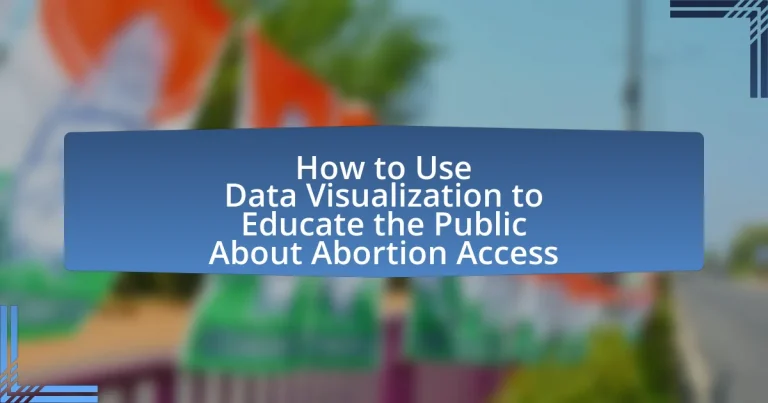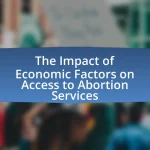Data visualization is a crucial tool for educating the public about abortion access, as it transforms complex data related to services, policies, and demographics into clear graphical representations. This article explores how data visualization enhances understanding of abortion access by illustrating geographic disparities, legal restrictions, and demographic information. It discusses the types of data that can be visualized, the impact of visualizations on public perception, and the importance of combating misinformation. Additionally, the article outlines effective strategies for creating compelling visual narratives, the role of advocacy groups, and best practices for communicating data effectively to diverse audiences.
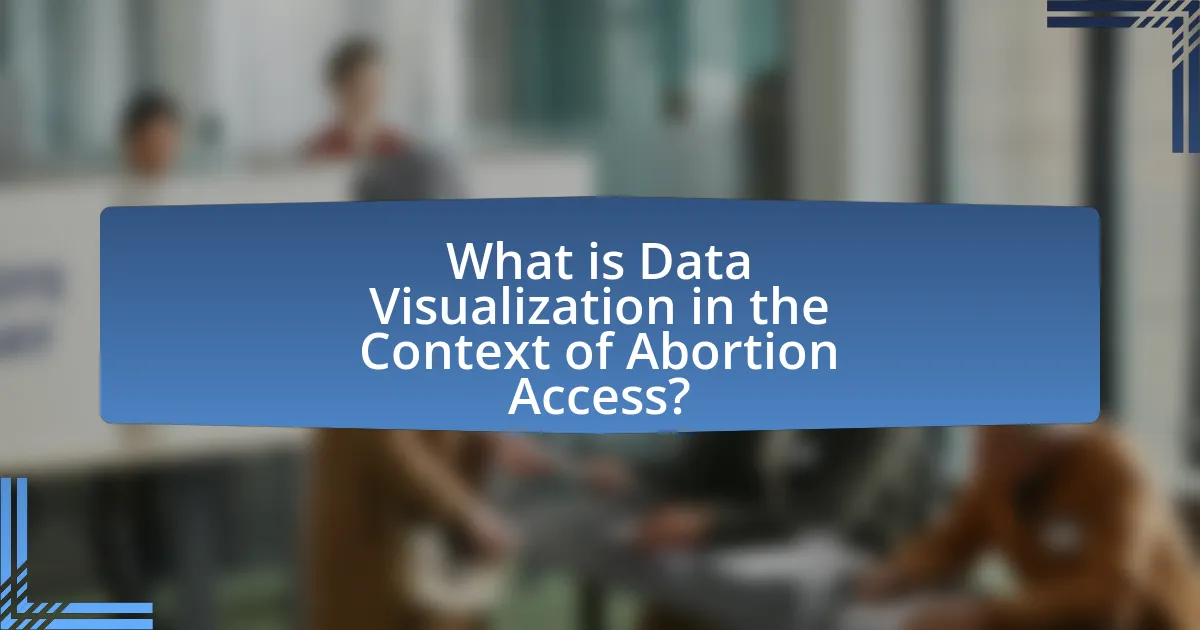
What is Data Visualization in the Context of Abortion Access?
Data visualization in the context of abortion access refers to the graphical representation of data related to abortion services, policies, and demographics to enhance understanding and inform public discourse. This method allows stakeholders, including policymakers and the public, to interpret complex data sets, such as the availability of clinics, state regulations, and demographic disparities in access to abortion services. For instance, a study by the Guttmacher Institute highlights that visualizing state-by-state access to abortion services can reveal significant disparities, with some states having numerous clinics while others have none, thereby illustrating the geographic and socio-economic barriers faced by individuals seeking abortions.
How does data visualization enhance understanding of abortion access?
Data visualization enhances understanding of abortion access by presenting complex data in a clear and accessible format, allowing individuals to grasp trends, disparities, and geographic variations quickly. For instance, visual tools like maps and charts can illustrate the availability of abortion services across different regions, highlighting areas with limited access. Research from the Guttmacher Institute indicates that states with restrictive abortion laws often show significant disparities in access, which can be effectively communicated through visual representations. By transforming raw data into visual formats, stakeholders can better engage with the information, leading to informed discussions and policy decisions regarding abortion access.
What types of data can be visualized to represent abortion access?
Various types of data can be visualized to represent abortion access, including geographic distribution of clinics, state laws and regulations, demographic information of individuals seeking abortions, and statistics on abortion rates. Geographic data can illustrate the proximity of clinics to populations, highlighting areas with limited access. Legal data can show the differences in state-level restrictions, such as waiting periods and parental consent laws, which affect accessibility. Demographic data can provide insights into the age, income, and racial background of individuals seeking abortions, revealing disparities in access. Additionally, statistics on abortion rates can indicate trends over time and the impact of policy changes. These data types collectively enhance understanding of the complexities surrounding abortion access.
How do visualizations impact public perception of abortion access?
Visualizations significantly influence public perception of abortion access by simplifying complex data and making it more relatable. For instance, infographics that depict statistics on abortion rates, demographic information, and access barriers can evoke emotional responses and foster understanding among viewers. Research indicates that visual representations can enhance retention of information, with studies showing that people are 65% more likely to remember information presented visually compared to text alone. This increased retention can lead to more informed opinions and discussions surrounding abortion access, ultimately shaping societal attitudes and policy considerations.
Why is educating the public about abortion access important?
Educating the public about abortion access is important because it empowers individuals to make informed decisions regarding their reproductive health. Knowledge about available options, legal rights, and potential barriers can significantly influence personal choices and public policy. For instance, studies show that states with comprehensive sex education and accessible information about abortion services have lower rates of unintended pregnancies and better health outcomes for women. By increasing awareness, communities can advocate for equitable access to healthcare services, ultimately leading to improved reproductive rights and health equity.
What role does misinformation play in public understanding of abortion access?
Misinformation significantly distorts public understanding of abortion access by perpetuating false narratives and misconceptions. For instance, studies show that misleading information about the safety and legality of abortion can lead to increased stigma and fear among individuals seeking care. A survey conducted by the Guttmacher Institute found that 75% of respondents held at least one incorrect belief about abortion laws, which can directly influence their perceptions and decisions regarding access. This misinformation can create barriers to care, as individuals may avoid seeking services due to fear of legal repercussions or health risks that are not substantiated by evidence.
How can data visualization counteract misinformation?
Data visualization can counteract misinformation by presenting complex data in a clear and accessible format, enabling audiences to understand and interpret information accurately. For instance, visual representations of abortion access statistics can highlight disparities and trends, making it easier for individuals to grasp the realities of the situation. Research shows that people are more likely to retain information presented visually; a study by the University of Minnesota found that visuals can improve comprehension by up to 400%. By effectively communicating factual data through charts, graphs, and infographics, data visualization helps dispel myths and clarify misunderstandings surrounding abortion access.
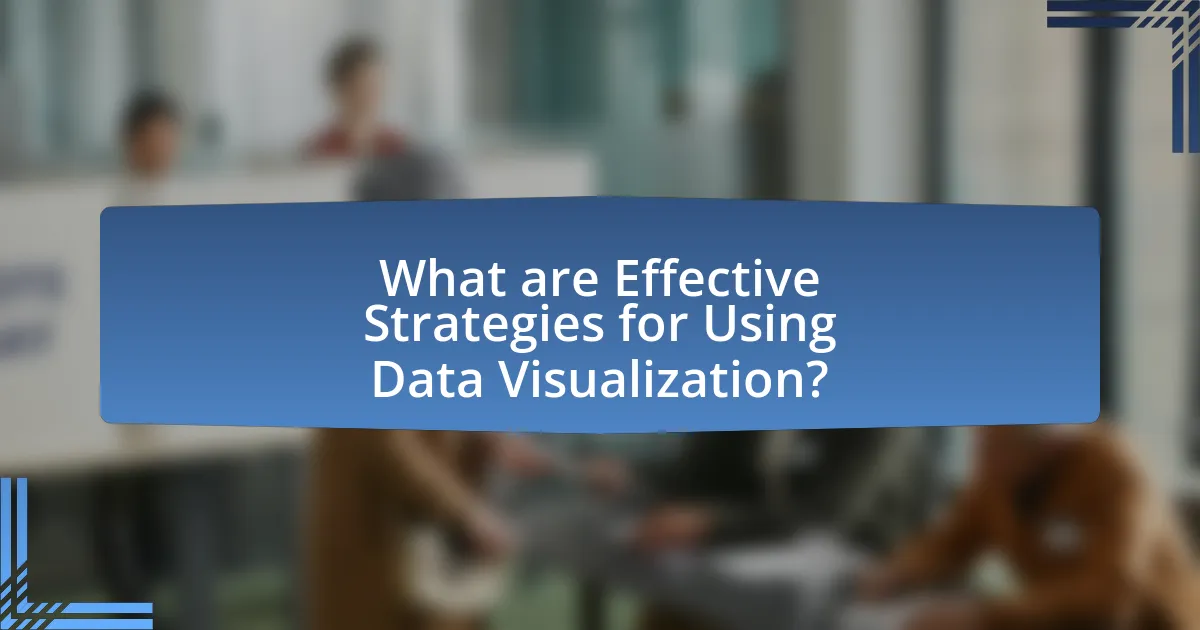
What are Effective Strategies for Using Data Visualization?
Effective strategies for using data visualization include selecting the appropriate type of visualization, ensuring clarity and simplicity, and tailoring the content to the audience’s needs. Choosing the right visualization type, such as bar charts for comparisons or line graphs for trends, enhances comprehension. Clarity and simplicity are crucial; avoiding clutter and using clear labels helps convey the message effectively. Tailoring content involves understanding the audience’s background and interests, which can increase engagement and retention of information. Research indicates that well-designed visualizations can improve understanding by up to 400% compared to text-based data alone, highlighting the importance of these strategies in effectively communicating complex topics like abortion access.
How can storytelling be integrated into data visualization for abortion access?
Storytelling can be integrated into data visualization for abortion access by using narrative techniques to contextualize data, making it more relatable and impactful. For instance, visualizations can incorporate personal stories or testimonials alongside statistical data, allowing viewers to connect emotionally with the information presented. Research shows that narratives can enhance understanding and retention of complex data; a study published in the journal “Health Communication” found that storytelling significantly improved audience engagement and comprehension of health-related topics. By combining quantitative data, such as access statistics and demographic information, with qualitative narratives, data visualizations can effectively convey the real-life implications of abortion access, fostering a deeper understanding among the public.
What are the key elements of a compelling data story?
A compelling data story includes a clear narrative, relevant data, visualizations, and emotional engagement. The narrative provides context and guides the audience through the data, while relevant data ensures the story is grounded in facts. Visualizations enhance understanding by making complex information accessible, and emotional engagement connects the audience to the subject matter, making the data more relatable. For instance, studies show that stories incorporating emotional elements can increase retention of information by up to 65%, highlighting the importance of emotional engagement in data storytelling.
How can narratives enhance the emotional impact of data visualizations?
Narratives enhance the emotional impact of data visualizations by providing context and relatable stories that resonate with the audience. When data is presented alongside a narrative, it transforms abstract numbers into human experiences, making the information more accessible and engaging. For instance, a visualization depicting abortion access statistics can be paired with personal stories of individuals affected by these issues, which can evoke empathy and a deeper understanding of the implications behind the data. Research shows that storytelling can significantly increase retention and emotional engagement, as evidenced by a study published in the journal “Cognitive Science,” which found that narratives improve memory recall by up to 22%. This combination of narrative and data visualization not only informs but also motivates action by connecting the audience emotionally to the subject matter.
What tools and platforms are available for creating data visualizations?
Tools and platforms available for creating data visualizations include Tableau, Microsoft Power BI, Google Data Studio, D3.js, and Plotly. Tableau is widely recognized for its user-friendly interface and powerful analytics capabilities, making it suitable for both beginners and advanced users. Microsoft Power BI integrates seamlessly with other Microsoft products and offers robust data modeling features. Google Data Studio provides a free, web-based solution that allows for easy sharing and collaboration. D3.js is a JavaScript library that enables developers to create highly customizable visualizations, while Plotly offers both a user-friendly interface and advanced coding options for interactive graphs. These tools are validated by their widespread use in various industries for effective data representation and analysis.
Which software options are best for beginners in data visualization?
Tableau, Microsoft Power BI, and Google Data Studio are the best software options for beginners in data visualization. Tableau offers a user-friendly interface with drag-and-drop functionality, making it accessible for those new to data visualization. Microsoft Power BI integrates seamlessly with other Microsoft products and provides a straightforward setup for creating interactive reports. Google Data Studio is free and allows users to create customizable dashboards easily, making it ideal for beginners. These tools are widely recognized for their ease of use and robust features, which support effective data storytelling.
How can advanced tools improve the quality of visualizations?
Advanced tools can improve the quality of visualizations by enabling more accurate data representation and enhancing user interactivity. These tools, such as advanced analytics software and machine learning algorithms, allow for the processing of large datasets, which leads to more precise insights and trends. For instance, tools like Tableau and Power BI utilize sophisticated algorithms to create dynamic visualizations that can adapt based on user input, thereby providing tailored insights. Additionally, the integration of real-time data feeds ensures that visualizations reflect the most current information, which is crucial for topics like abortion access where data can rapidly change. This capability not only improves the clarity of the visualizations but also enhances their relevance and impact on public understanding.
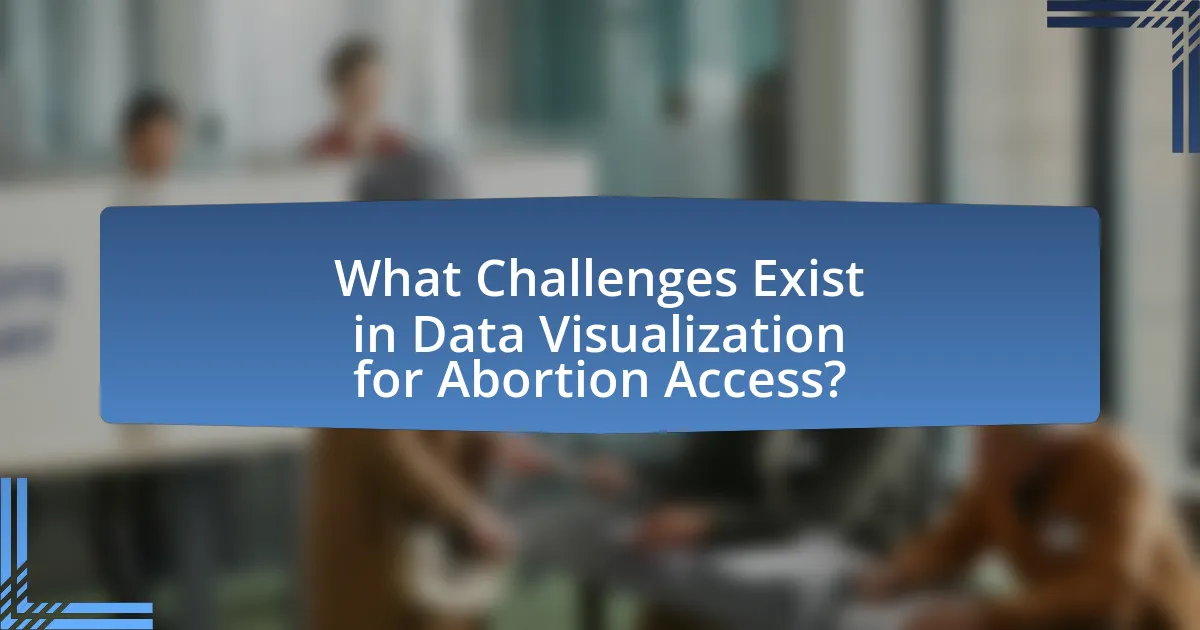
What Challenges Exist in Data Visualization for Abortion Access?
Data visualization for abortion access faces several challenges, including data availability, data sensitivity, and the complexity of legal frameworks. Limited access to comprehensive and reliable data on abortion services can hinder effective visualization efforts, as many regions lack transparent reporting mechanisms. Additionally, the sensitive nature of abortion data often leads to privacy concerns, making it difficult to obtain accurate information without compromising individual confidentiality. Furthermore, the varying legal contexts surrounding abortion across different jurisdictions complicate the creation of standardized visualizations, as laws and access points differ significantly. These challenges collectively impede the ability to create clear, informative, and actionable visual representations of abortion access.
What are common pitfalls in data visualization related to abortion access?
Common pitfalls in data visualization related to abortion access include oversimplification, misleading scales, and lack of context. Oversimplification occurs when complex data is presented without sufficient detail, leading to misinterpretation of the issues surrounding abortion access. Misleading scales can distort the perception of data trends; for example, using non-linear scales can exaggerate or downplay significant changes in access rates. Lack of context, such as failing to include demographic information or geographic disparities, can result in a skewed understanding of the data, as seen in studies that highlight national averages without addressing local variations. These pitfalls can hinder effective communication and understanding of abortion access issues.
How can bias affect the interpretation of data visualizations?
Bias can significantly distort the interpretation of data visualizations by influencing how data is presented and perceived. For instance, if a visualization emphasizes certain data points while downplaying others, it can lead viewers to draw misleading conclusions. Research shows that visual elements such as color, scale, and layout can introduce bias; for example, a study by Cleveland and McGill (1984) demonstrated that people are more likely to accurately interpret length comparisons than area or volume comparisons. This indicates that the choice of visualization type can skew understanding, particularly in sensitive topics like abortion access, where misinterpretation can affect public opinion and policy decisions.
What strategies can be employed to ensure accuracy in visualizations?
To ensure accuracy in visualizations, employing strategies such as data validation, appropriate scaling, and clear labeling is essential. Data validation involves verifying the accuracy and reliability of the data sources used, which can prevent misleading representations. Appropriate scaling ensures that the visual representation accurately reflects the data’s magnitude, avoiding distortions that can mislead viewers. Clear labeling of axes, legends, and data points enhances understanding and prevents misinterpretation of the information presented. These strategies collectively contribute to creating trustworthy visualizations that effectively communicate the intended message regarding abortion access.
How can stakeholders collaborate to improve data visualization efforts?
Stakeholders can collaborate to improve data visualization efforts by establishing clear communication channels and sharing resources effectively. For instance, healthcare organizations, advocacy groups, and data analysts can work together to define common goals and identify key metrics that need visualization. Collaborative workshops can facilitate the exchange of ideas and best practices, ensuring that visualizations are not only accurate but also resonate with the target audience. Research shows that effective collaboration leads to more comprehensive data interpretations, as evidenced by the success of initiatives like the “Data for Health” program, which improved public health outcomes through shared data visualization efforts among various stakeholders.
What roles do advocacy groups play in data visualization initiatives?
Advocacy groups play a crucial role in data visualization initiatives by providing essential data, context, and narratives that highlight issues related to abortion access. These organizations often collect and analyze data on abortion services, access barriers, and public opinion, which they then translate into visual formats that are accessible and engaging for the public. For instance, the Guttmacher Institute regularly publishes data visualizations that illustrate trends in abortion access, helping to inform policymakers and the public about the implications of legislative changes. By leveraging their expertise and resources, advocacy groups ensure that data visualizations effectively communicate the urgency and significance of abortion access issues, thereby fostering informed public discourse and advocacy efforts.
How can partnerships enhance the reach and impact of visualizations?
Partnerships can enhance the reach and impact of visualizations by leveraging diverse networks and expertise to disseminate information more effectively. Collaborating with organizations that have established audiences, such as healthcare providers or advocacy groups, allows for broader distribution of visual content, ensuring it reaches various demographics. For instance, a partnership with a reproductive health organization can facilitate access to their followers, increasing visibility and engagement with the visualization. Additionally, combining resources and knowledge from different entities can lead to more comprehensive and accurate visualizations, which can resonate better with the target audience, ultimately driving greater awareness and understanding of abortion access issues.
What are best practices for effectively communicating data visualizations?
Best practices for effectively communicating data visualizations include ensuring clarity, simplicity, and relevance. Clarity involves using clear labels, legends, and titles to help the audience understand the data being presented. Simplicity means avoiding unnecessary complexity in design, which can distract from the main message; for example, using straightforward charts like bar graphs or line charts instead of overly intricate visualizations. Relevance requires tailoring the visualization to the audience’s needs and context, ensuring that the data presented directly addresses their interests or questions. Research by the Data Visualization Society indicates that effective visualizations can increase comprehension by up to 80%, highlighting the importance of these practices in enhancing understanding and engagement.
How can clarity and simplicity be prioritized in visualizations?
Clarity and simplicity in visualizations can be prioritized by using straightforward design elements and limiting the amount of information presented. Effective visualizations should utilize clear labels, consistent color schemes, and minimal text to enhance understanding. Research indicates that visualizations with fewer data points and simplified graphics lead to better comprehension, as demonstrated in studies by the Nielsen Norman Group, which found that users prefer visuals that convey information quickly and without unnecessary complexity. By focusing on essential data and avoiding clutter, visualizations can effectively communicate critical information about abortion access to the public.
What techniques can be used to engage diverse audiences with data?
To engage diverse audiences with data, techniques such as storytelling, interactive visualizations, and culturally relevant design can be employed. Storytelling helps contextualize data, making it relatable and memorable; for instance, using narratives that reflect the experiences of individuals affected by abortion access can resonate deeply with various demographics. Interactive visualizations allow users to explore data at their own pace, catering to different learning styles and preferences, which can enhance understanding and retention. Culturally relevant design ensures that visual elements, language, and symbols resonate with specific communities, increasing engagement and comprehension. Research indicates that these techniques can significantly improve audience connection and understanding, as evidenced by studies showing that narratives can increase empathy and retention of information by up to 65%.
What are practical tips for using data visualization to educate the public about abortion access?
Practical tips for using data visualization to educate the public about abortion access include employing clear and concise graphics, utilizing interactive elements, and ensuring accessibility. Clear graphics, such as infographics, can effectively communicate statistics about abortion rates and access barriers, making complex information digestible. Interactive elements, like maps showing clinic locations and service availability, engage users and allow them to explore data relevant to their communities. Ensuring accessibility involves using color-blind friendly palettes and providing alternative text for images, which broadens the audience and enhances understanding. According to a study by the Pew Research Center, visual data representation significantly improves information retention, underscoring the effectiveness of these strategies in educating the public.
